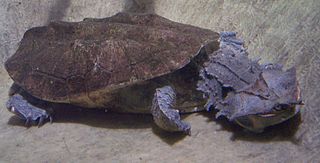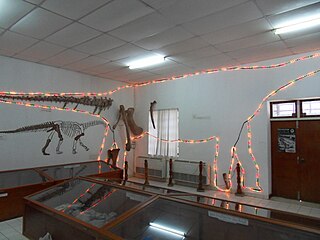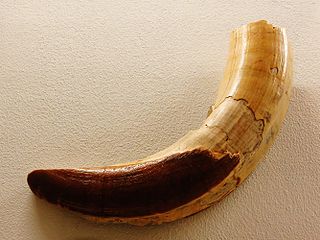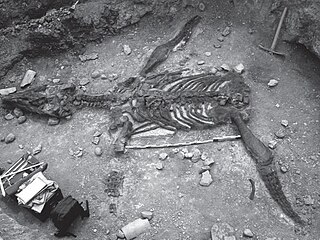
In taxonomy, binomial nomenclature, also called binominal nomenclature or binary nomenclature, is a formal system of naming species of living things by giving each a name composed of two parts, both of which use Latin grammatical forms, although they can be based on words from other languages. Such a name is called a binomial name, a binomen, binominal name or a scientific name; more informally it is also called a Latin name.

Chelidae is one of three living families of the turtle suborder Pleurodira, and are commonly called Austro-South American side-neck turtles. The family is distributed in Australia, New Guinea, parts of Indonesia, and throughout most of South America. It is a large family of turtles with a significant fossil history dating back to the Cretaceous. The family is entirely Gondwanan in origin, with no members found outside Gondwana, either in the present day or as a fossil.

Giovanni Antonio Scopoli was an Italian physician and naturalist. His biographer Otto Guglia named him the "first anational European" and the "Linnaeus of the Austrian Empire".

In biology, a type is a particular specimen of an organism to which the scientific name of that organism is formally attached. In other words, a type is an example that serves to anchor or centralize the defining features of that particular taxon. In older usage, a type was a taxon rather than a specimen.

Anthurium is a genus of about 1,000 species of flowering plants, the largest genus of the arum family, Araceae. General common names include anthurium, tailflower, flamingo flower, and laceleaf.

André Jean Baptiste Robineau-Desvoidy was a French physician and entomologist specialising in the study of Diptera (flies) and to some extent of the Coleoptera (beetles).
In zoological nomenclature, author citation refers to listing the person who first makes a scientific name of a taxon available. This is done in a scientific publication while fulfilling the formal requirements under the International Code of Zoological Nomenclature, hereinafter termed "the Code". According to the Code, "the name of the author does not form part of the name of a taxon and its citation is optional, although customary and often advisable", however Recommendation 51A suggests: "The original author and date of a name should be cited at least once in each work dealing with the taxon denoted by that name. This is especially important in distinguishing between homonyms and in identifying species-group names which are not in their original combinations". For the purpose of information retrieval, the author citation and year appended to the scientific name, e.g. genus-species-author-year, genus-author-year, family-author-year, etc., is often considered a "de facto" unique identifier, although for a number of reasons discussed below, this usage may often be imperfect.

The Anthomyiidae are a large and diverse family of Muscoidea flies. Most look rather like small houseflies, but are commonly drab grey. The genus Anthomyia, in contrast, is generally conspicuously patterned in black-and-white or black-and-silvery-grey. Most are difficult to identify, apart from a few groups such as the kelp flies that are conspicuous on beaches.

Tangvayosaurus is a genus of sauropod dinosaur from the Aptian-Albian age Lower Cretaceous Gres superieurs Formation of Savannakhet Province, Laos. It was a basal somphospondylan, about 15 m long, and is known from the remains of two or three individuals.

Phuwiangosaurus is a genus of titanosaur dinosaur from the Early Cretaceous (Valanginian-Hauterivian) Sao Khua Formation of Thailand. The type species, P. sirindhornae, was described by Martin, Buffetaut, and Suteethorn in a 1993 press release and was formally named in 1994. The species was named to honor Princess Maha Chakri Sirindhorn of Thailand, who was interested in the geology and palaeontology of Thailand, while the genus was named after the Phu Wiang area, where the fossil was discovered.
Brasileodactylus a genus of pterosaur from the Aptian-age lower Santana formation of Chapada do Araripe, Ceará, Brazil.

Elseya is a genus of large side-necked turtles, commonly known as Australian snapping turtles, in the family Chelidae. Species in the genus Elseya are found in river systems in northern and northeastern Australia and throughout the river systems of New Guinea. They are identified by the presence of alveolar ridges on the triturating surfaces of the mouth and the presence of a complex bridge strut.

Mungos is a mongoose genus that was proposed by Étienne Geoffroy Saint-Hilaire and Frédéric Cuvier in 1795.

Eois is a genus of moths in the family Geometridae. The genus contains about 250 validly described species, most from the Neotropical region. Many species are still undescribed and the total number of species is estimated to be over a 1,000 in the Neotropical region alone. The genus was first described by Jacob Hübner in 1818.

Byturidae, also known as Fruitworms, is a very small family of beetles, in the suborder Polyphaga, comprising fewer than 20 species worldwide. The larvae of some species develop in fruits. Byturus unicolor affects species of Rubus and Geum.
Ixorheis is a genus of parasitic alveolates in the phylum Apicomplexa.

Parastrapotherium is an extinct genus of South American land mammal that existed from the Late Oligocene to the Early Miocene. The genus includes some of the largest and smallest known astrapotherian, but at present no generally recognized description can adequately characterize it.

Gracillariinae are a subfamily of moths which was described by Henry Tibbats Stainton in 1854.
John Ernest "Jack" Randall was an American ichthyologist and a leading authority on coral reef fishes. Randall described over 800 species and authored 11 books and over 900 scientific papers and popular articles. He spent most of his career working in Hawaii. He died in April 2020 at the age of 95.

Stenorhynchosaurus is an extinct genus of pliosaurid plesiosaurs which lived in South America during the Early Cretaceous. The type species and only known is Stenorhynchosaurus munozi.
















